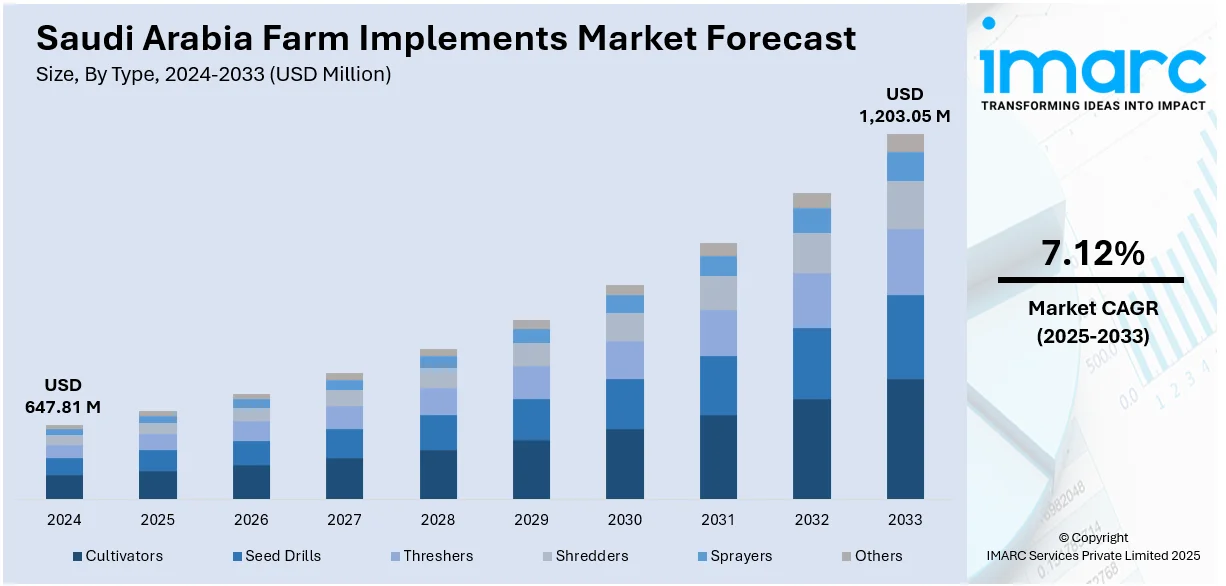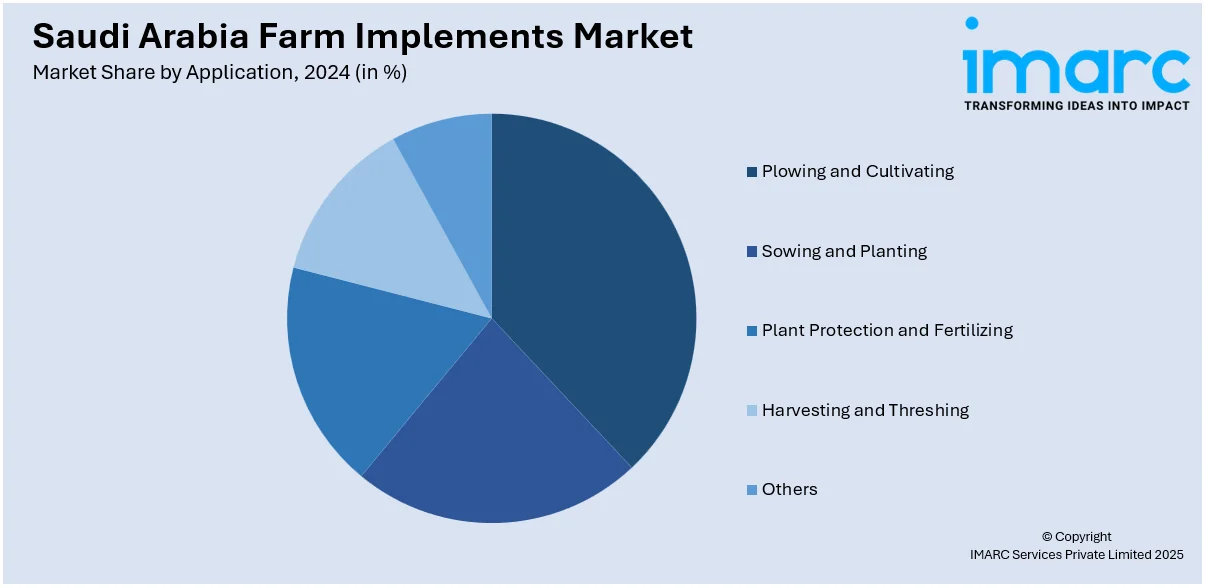
Saudi Arabia Farm Implements Market Size, Share, Trends and Forecast by Type, Application, and Region, 2025-2033
Saudi Arabia Farm Implements Market Overview:
The Saudi Arabia farm implements market size reached USD 647.81 Million in 2024. Looking forward, IMARC Group expects the market to reach USD 1,203.05 Million by 2033, exhibiting a growth rate (CAGR) of 7.12% during 2025-2033. The market is driven by Vision 2030 initiatives promoting mechanized agriculture for food security and sustainability. Expansion of commercial farming and agro-industrial development is increasing demand for high-capacity, precision implements, thereby fueling the market. Labor shortages and workforce optimization challenges further necessitate mechanization, collectively augmenting the Saudi Arabia farm implements market share.
|
Report Attribute
|
Key Statistics
|
|---|---|
|
Base Year
|
2024
|
|
Forecast Years
|
2025-2033
|
|
Historical Years
|
2019-2024
|
| Market Size in 2024 | USD 647.81 Million |
| Market Forecast in 2033 | USD 1,203.05 Million |
| Market Growth Rate 2025-2033 | 7.12% |
Saudi Arabia Farm Implements Market Trends:
Agricultural Modernization under Vision 2030
Saudi Arabia’s Vision 2030 places significant emphasis on modernizing the agricultural sector to enhance food security and reduce dependency on imports. The government is actively promoting mechanization as a core strategy to improve productivity and sustainability. Investments in irrigation infrastructure, land reclamation, and mechanized farming practices are expanding rapidly, driving demand for advanced farm implements tailored to the arid and desert environment. Subsidies and financial incentives for farmers encourage the adoption of tractors, tillers, seeders, and harvesters equipped with technology suited for large-scale cultivation. Modern implements enable efficient water management, soil preparation, and crop management, critical in resource-scarce regions. Public-private partnerships and research initiatives also focus on localizing equipment to meet Saudi Arabia’s specific agricultural challenges. On January 20, 2025, Saudi agritech startup Arable closed a USD 2.55 million seed funding round, primarily supported by foreign investors, to develop hydroponic farming systems tailored for Saudi Arabia’s arid climate. Founded in 2024, Arable’s technology enables farms to be established four times faster and at 2.5 times lower operational cost compared to existing solutions, with 80% of components sourced locally. This investment supports the Saudi Arabia farm implements market by advancing sustainable, cost-effective agricultural innovations aligned with Vision 2030’s goals of food security and increased local production. These efforts collectively support the Saudi Arabia farm implements market growth by facilitating large-scale, efficient, and sustainable farming operations aligned with national priorities.

Expansion of Agribusiness and Commercial Farming
The shift from traditional small-scale farming to commercial agribusiness in Saudi Arabia is reshaping the demand for sophisticated farm equipment. Large agribusiness enterprises require high-capacity, durable implements capable of handling extensive land parcels and diverse crop cycles efficiently. The introduction of mechanized tools such as precision seeders, automatic irrigation systems, and multi-functional tractors supports the scaling of operations and cost optimization. The government’s focus on developing agro-industrial zones and export-oriented farming further intensifies the need for reliable, high-performance machinery. On 24th October 2024, Saudi Arabia’s Ministry of Environment, Water, and Agriculture announced it had attracted over USD 9.8 billion (SAR 37 billion) in private sector investments for sustainable agriculture and food sector projects. These initiatives span crop production, livestock, fisheries, food processing, and infrastructure, aligned with Vision 2030 and the National Agriculture Strategy 2034. Moreover, rising awareness about crop quality and yield consistency is driving adoption of implements that integrate data analytics and precision farming capabilities. This transition toward commercialized agriculture creates robust market demand for versatile, technologically advanced implements capable of enhancing operational efficiency, productivity, and competitiveness across the agricultural value chain.
Saudi Arabia Farm Implements Market Segmentation:
IMARC Group provides an analysis of the key trends in each segment of the market, along with forecasts at the country and regional levels for 2025-2033. Our report has categorized the market based on type and application.
Type Insights:
- Cultivators
- Seed Drills
- Threshers
- Shredders
- Sprayers
- Others
The report has provided a detailed breakup and analysis of the market based on the type. This includes cultivators, seed drills, threshers, shredders, sprayers, and others.
Application Insights:

- Plowing and Cultivating
- Sowing and Planting
- Plant Protection and Fertilizing
- Harvesting and Threshing
- Others
The report has provided a detailed breakup and analysis of the market based on the application. This includes plowing and cultivating, sowing and planting, plant protection and fertilizing, harvesting and threshing, and others.
Regional Insights:
- Northern and Central Region
- Western Region
- Eastern Region
- Southern Region
The report has also provided a comprehensive analysis of all major regional markets. This includes Northern and Central Region, Western Region, Eastern Region, and Southern Region.
Competitive Landscape:
The market research report has also provided a comprehensive analysis of the competitive landscape. Competitive analysis such as market structure, key player positioning, top winning strategies, competitive dashboard, and company evaluation quadrant has been covered in the report. Also, detailed profiles of all major companies have been provided.
Saudi Arabia Farm Implements Market News:
- On February 11, 2025, Hyliion Holdings Corp. signed a non-binding Letter of Intent with Saudi Arabia’s Al Khorayef Group to deploy up to twelve 200 kW KARNO™ generator units for use in agricultural power applications. These generators, designed for remote farms and irrigation systems, operate initially on liquefied petroleum gas and natural gas, offering high efficiency, low emissions, and minimal maintenance, aligning with Saudi Arabia’s Vision 2030 sustainability goals.
Saudi Arabia Farm Implements Market Report Coverage:
| Report Features | Details |
|---|---|
| Base Year of the Analysis | 2024 |
| Historical Period | 2019-2024 |
| Forecast Period | 2025-2033 |
| Units | Million USD |
| Scope of the Report |
Exploration of Historical Trends and Market Outlook, Industry Catalysts and Challenges, Segment-Wise Historical and Future Market Assessment:
|
| Types Covered | Cultivators, Seed Drills, Threshers, Shredders, Sprayers, Others |
| Applications Covered | Plowing and Cultivating, Sowing and Planting, Plant Protection and Fertilizing, Harvesting and Threshing, Others |
| Regions Covered | Northern and Central Region, Western Region, Eastern Region, Southern Region |
| Customization Scope | 10% Free Customization |
| Post-Sale Analyst Support | 10-12 Weeks |
| Delivery Format | PDF and Excel through Email (We can also provide the editable version of the report in PPT/Word format on special request) |
Key Questions Answered in This Report:
- How has the Saudi Arabia farm implements market performed so far and how will it perform in the coming years?
- What is the breakup of the Saudi Arabia farm implements market on the basis of type?
- What is the breakup of the Saudi Arabia farm implements market on the basis of application?
- What is the breakup of the Saudi Arabia farm implements market on the basis of region?
- What are the various stages in the value chain of the Saudi Arabia farm implements market?
- What are the key driving factors and challenges in the Saudi Arabia farm implements market?
- What is the structure of the Saudi Arabia farm implements market and who are the key players?
- What is the degree of competition in the Saudi Arabia farm implements market?
Key Benefits for Stakeholders:
- IMARC’s industry report offers a comprehensive quantitative analysis of various market segments, historical and current market trends, market forecasts, and dynamics of the Saudi Arabia farm implements market from 2019-2033.
- The research report provides the latest information on the market drivers, challenges, and opportunities in the Saudi Arabia farm implements market.
- Porter's five forces analysis assist stakeholders in assessing the impact of new entrants, competitive rivalry, supplier power, buyer power, and the threat of substitution. It helps stakeholders to analyze the level of competition within the Saudi Arabia farm implements industry and its attractiveness.
- Competitive landscape allows stakeholders to understand their competitive environment and provides an insight into the current positions of key players in the market.
Need more help?
- Speak to our experienced analysts for insights on the current market scenarios.
- Include additional segments and countries to customize the report as per your requirement.
- Gain an unparalleled competitive advantage in your domain by understanding how to utilize the report and positively impacting your operations and revenue.
- For further assistance, please connect with our analysts.
 Request Customization
Request Customization
 Speak to an Analyst
Speak to an Analyst
 Request Brochure
Request Brochure
 Inquire Before Buying
Inquire Before Buying




.webp)




.webp)












